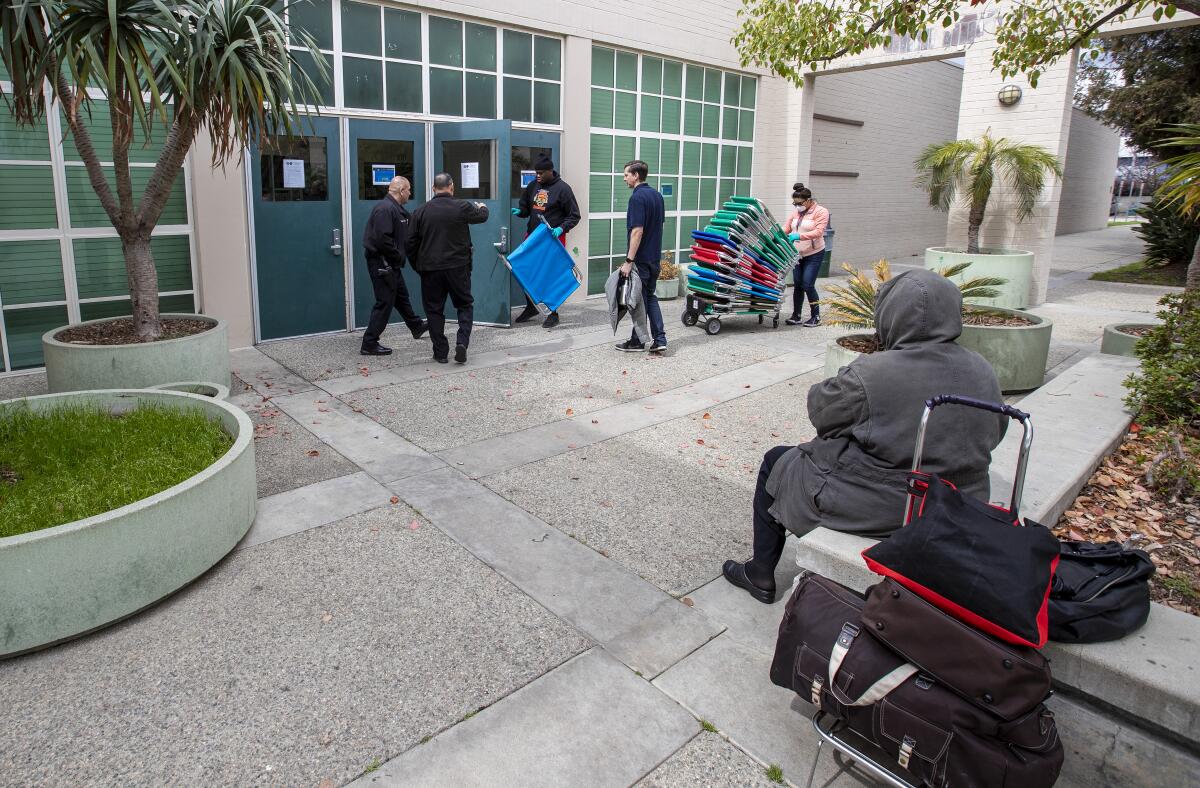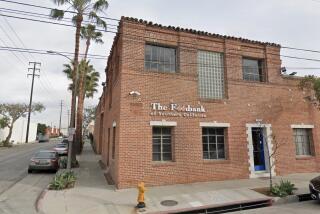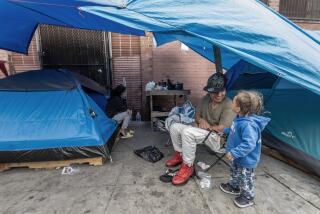Salvation Army offers stores and camps as homeless shelters amid outbreak, but it’s a leap

Just like for-profit businesses across California, the Salvation Army has taken a hit from the social distancing measures enacted to slow the spread of the coronavirus.
On Wednesday, with foot traffic drained, the giant nonprofit best known for its Christmastime bell ringers shut down 17 thrift stores in Los Angeles County and 10 in Orange County.
The next day, top brass from the military-structured organization made an unexpected appearance in federal court in Los Angeles, offering up its stores and several other facilities as part of the response to COVID-19, which threatens to ravage homeless encampments across the city.
The Salvation Army is now in talks with the Los Angeles Homeless Services Authority to determine if any of its facilities, which include two mountain camps and an 80,000-square-foot warehouse in the city of Bell, would be useful for housing homeless people — either to prevent them from being exposed to the virus or to quarantine those who may come down with it.
It’s a long shot.
In an interview, Heidi Marston, interim executive director of the homeless authority, tried to put a damper on the prospects for opening homeless shelters in the nonprofit’s 27 thrift stores, which are still full of merchandise.
“So it’s about whether the juice is worth the squeeze,” Marston said.
But she said there’s potential in the Bell warehouse and at the mountain camps.
The talks were an unexpected sideshow in an unorthodox emergency hearing called by U.S. District Court Judge David O. Carter to pressure officials from Los Angeles city and county for quick action on protecting homeless people from the virus.
While formally inviting officials including L.A. County Dist. Atty. Jackie Lacey and Los Angeles City Council President Nury Martinez, Carter placed a private call to the Salvation Army.
He knew two of its leaders, Commissioner Kenneth Hodder and Lt. Col. John Chamness, from their work setting up a shelter as part of the resolution to a lawsuit that forced officials in Orange County to add beds for homeless people.
Before Thursday’s federal court hearing was over, Carter had the Salvation Army officers confer with Marston in a corner of the courtroom to hash out a plan. The details proved too much for a quick breakthrough, though, and the two parties continued their talks over the weekend. They are due to report back to Carter on Tuesday.
Salvation Army spokeswoman Pilar Buelna said the nonprofit has given the homeless authority a list of the properties, but conceded that some of its thrift stores could be problematic. Besides the stock of used clothing and other products, which could be removed, some of the stores lack sprinklers or have other issues with city code that make them unsuitable for human habitation.
“They are looking to see if any are going to work out,” Buelna said Friday night.
Over the weekend, officials from the homeless authority visited the Bell warehouse and the youth summer camp in Calabasas, Buelna said.
Conferences at the camp have been suspended as a result of the pandemic. It has sleeping quarters, kitchen facilities and bathrooms to accommodate 500. Because of its isolation it would be good for quarantine, Buelna said.
The Salvation Army’s second camp in the Big Bear area was considered too remote, but would be available if needed, Buelna said.
The facility in Bell is part of a warehouse formerly on a U.S. Army Air Corps base. It was transferred to civilian use as a homeless shelter in 1988. Salvation Army currently operates a 350-bed shelter in about a third of the space. It uses the remainder for storing goods for its charitable activities. But there is ample empty space.
“We anticipate that that facility could accommodate as many as 1,500 people,” said Hodder, one of the two officers who attended the court hearing.
It could be used for triage, for housing those who are medically fragile or for quarantine, he said.
Hodder said the Salvation Army decided to offer all of its resources for whatever use could be made of them to help blunt the virus.
“Salvation Army would not have a single piece of property, we would not have a dime to our name without the extraordinary generosity of the American people,” Hodder said. “We believe we can do no less at this point, because of the extent and depth of this need, that everything the Salvation Army has is available to help.”
More to Read
Sign up for Essential California
The most important California stories and recommendations in your inbox every morning.
You may occasionally receive promotional content from the Los Angeles Times.








